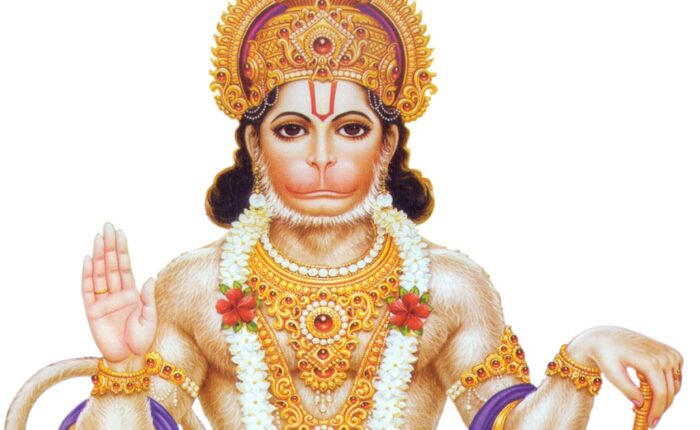Sri Hanuman Ji – The Lord of the Masses

Hanuman is the most popular deity of the masses in India and some other countries. While crisscrossing the country, particularly the north Indian territory, we find millions of big and small Hanuman temples in both rural and urban spaces. Many small and towering statues of the deity are found in the open without temples. Hanuman can be seen within the village, on the outskirts of villages, even in forests and along roads and highways indicating his wide mass base everywhere. He is always held in high esteem because He is ‘Veer’ (brave) and ‘Mahaveer’ (bravest) and is adorned for his ‘Veerata’ (bravery) in completing the tasks allotted to him by his supreme lord Ram. None other is regarded as a completely devoted servant of Ram and Sita as Hanuman has been portrayed in Balmiki Ramayan, Tulsi Ramayan, Adhyatma Ramayan, Anand Ramayan and other related scriptures.
In rural areas, He is worshipped as Gram Devata (Village deity) who protects them from all evils. He is also the Kuldevta of millions. He is also a popular god for the Dakshinmargi and Vaama margi tantrics and there are also tantric methods of his worship. Ramayana describes Ram and Sita in stories found in them as first coverage. But the second coverage in all the Ramayans is enjoyed by Hanuman who is the powerhouse of strength and strong will; He has been portrayed as completely free from arrogance, a celibate from childhood and a Supreme devotee. Women avoid touching the images of Hanuman because he is a “Bal Brahmachari” (a celibate). The Sundarkand of Ramcharita Manas is recited by millions for auspicious results. However, for the common masses, Hanuman Chalisa and Bajrang Baan are always at hand. Hanuman is a real Jana Devata (the deity of the masses).
This popularity is based on the narratives found in Balmiki Ramayan and Ramcharita Manas of Tulsi Das. His celibacy and internal strength are adorned by wrestlers. Hanuman temples are found near the grounds where wrestlers are trained and physical exercises are performed (Akharas). This particular trend was established by Tulsidas himself who adopted this method considering the necessities of his time.
Foundations in Valmiki Ramayan:
Adikavi Valmiki was the first to portray the character of Hanuman. He praised Hanuman himself profusely in his shlokas and he also saw that Sri Ram also praises his completely devoted and selfless servant. Ram while narrating the valour of Hanuman after victory in Lanka admitted in front of Rishi Agastya that none of these objectives could have been fulfilled without the fearless cooperation of Hanuman. Hanuman enters the story of Ramayan from Kiskindha Kand when Ram Lakshman, Surgriva and Hanuman meet for the first time. Thereafter, Hanuman becomes inseparable. Valmiki portrayed him as a manifestation of several virtues.
- He was portrayed as the most powerful and having superhuman strength who could uproot the Droanachal mountain itself to meet the requirements of herbs for the treatment of Lakshman.
- He has been portrayed as an incarnation of knowledge, intelligence and quick-wittedness as has been exemplified by his encounter with Nagmata Sursa, his techniques for introducing himself to Sita, his fearlessness in addressing the court of Ravan in captivity and his subsequent action of Lanka Dahan.
- He is depicted as a devotee who was able to transform himself into the required disguises and enjoyed the powers of eight Siddhis (accomplishments).
- He has also been portrayed as a consummate orator which provided foundations for friendship between Ram and Sugriva and the later narratives.
Tulsidas brought Hanuman closer to the Masses:
Tulsidas in his Ramcharita Manas has depicted Hanuman as the supreme devotee of Ram whose primary duty was to fulfill the commands of his lord. He was also a devotee of Sita, Lakshman, Bharat and Shatrughna but it was Ram who resided in his heart. Hanuman was a minister of King Sugriva but after the coronation of Ram as the King of Ayodhya, he requested Sugriva to relieve him from his ministerial duties. He preferred to go to the Himalayas for Tapasya with Ram in his heart.
Hanuman Chalisa composed by Sri Tulsidas is a highly popular prayer of Hanuman which always remains in memory of millions and millions of Hanuman devotees in India. People adore him and worship him. Ram Navami falls on the ninth day of Chaitra Shukla Paksha which is the birthday of Ram to whom Hanuman is devoted. This festival is celebrated with vigour and enthusiasm in the country with lots of Hanuman flags.
The forty-liner “Chaupais” and three “Dohas” make Hanuman Chalisa which is a complete prayer. Some exemplary lines in the Avadhi language of Tulsidas have been given below.
- Jaya Hanuman Gyan Guna Sagar, Jaya Kapish Tihun Loka Ujagar
- Ram Doota Atulita Baldhama, Anjani Putra Pavan Suta Nama
- Mahaveera Vikram Bajarangi, Kumati Nivar Sumati Ke Sangi
————————–
- Vidyavan Guni Ati Chatur, Ram Kaj Karibe Ko Atur
- Prabhu Charita Sunibe Ko Rasiya, Ram Lakshan Sita Maan Basiya
—————————–
- Durgam Kaj Jagat Ke Jete, Sugam Anugraha Tumare Tete
——————————
- Bhoota Pishacha Nikat Nahi Aawe, Mahaveera Jab Naam Sunavey
- Nasai Roga Harai Sab Peera, Japat Nirantar Hanumat Veera.
- Sankat Te Hanuman Chchudavain, Man, Krama, Vachan, Dhyan Jo Lavai.
Hanuman has been blessed with Immortality by his Lord Ram himself. Therefore, the story of Hanuman and his blessings will continue till the name of Ram persists on the earth.
I am a Vedic astrologer by profession. I have done Jyotish Acharya from Bhartiya Vidya Bhawan. I am devoted to my Sadguru Shri Sai Nath of Shirdi. I am also interested in spirituality. I love to guide people.